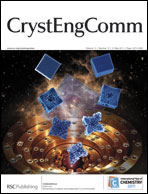Four new poly(oxomolybdophosphates), Na[FeIII(2,2′-bpy)3]2[FeII2Sr2MoV12O24(OH)6(H2O)8(H2PO4)2(HPO4)2(PO4)4]·[PO4]·9H2O 1, [H2(bpp)]2[MnII2Sr2Mo12O24(OH)6(H2O)8(H2PO4)2(HPO4)2(PO4)4]·8H2O 2, [H2(4,4′-bpy)]2[CdII2Sr2Mo12O24(OH)6(H2O)6(H2PO4)2(HPO4)2(PO4)4]·5H2O 3 and [H2(4,4′-bpy)][MnII2Sr4Mo12O24(OH)6(H2O)12(HPO4)4(PO4)4]·8H2O 4 (2,2′-bpy = 2,2′-bipyridine, bpp = 1,3-bi(4-pyridyl)-propane, 4,4′-bpy = 4,4′-bipyridine), have been hydrothermally synthesized and structurally characterized by elemental analysis, TG, IR, UV-vis and single-crystal X-ray diffraction. All the compounds are based on the [P4Mo6O31]12− (abbreviated as [P4Mo6]) polyoxometalate units, which are further connected into sandwich-type dimeric units by various transition metal (TM) ions. In compounds 1–3, the dimeric {(TM)[P4Mo6]2} units are linked by new {Sr2TM} trinuclear fragments into one-dimensional (1-D) chains. These 1-D chains are further packed into various three-dimensional (3-D) supramolecular assemblies due to the use of different bipyridine-based structure-directing agents. In compound 4, the dimeric {(TM)[P4Mo6]2} units are linkered by an unprecedented {Sr4Mn} pentanuclear unit into new 3-D open framework, exhibiting a 64.82-nbo (niobium-oxide-like) topology. The electrochemical properties of these compounds were investigated.


 Please wait while we load your content...
Please wait while we load your content...